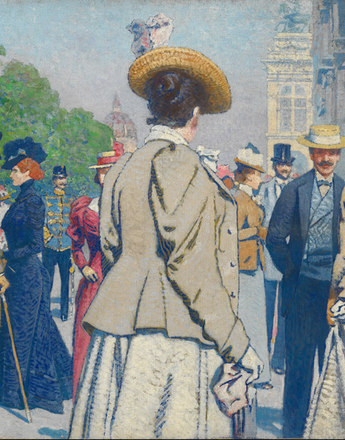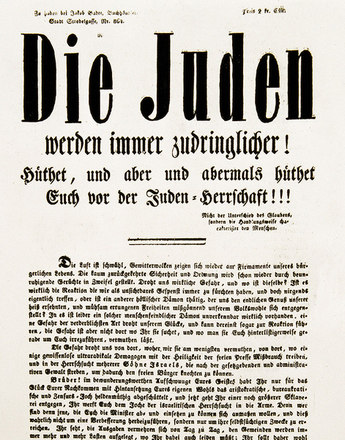Antisemitism: A historical definition
First used in the German press in 1879, the term anti-Semitism rapidly became popular, and stood for the ideologization of hostility to Jews, presenting the "Jewish question" as the solution to social and political crises.
In the German-speaking world, the racially-based term anti-Semitism had since the 1880s become a political slogan used by German anti-Semites to distinguish their secular-based hostility to the Jews from one based on religious grounds. This neologism expressed a change that had already begun in the early 19th century, defining Jews no longer primarily through their membership of their religion but instead regarding the Jews as a separate group and members of a people. In the context of growing nationalism, a racial belief developed according to which the Jewish population was an alien "race" that threatened national unity. This led to the emergence of anti-Semitic movements with the aim of preventing or revoking the equal treatment and integration of Jews.
In this, the 1880s represented a reversal of public opinion. Antisemitism became a social movement that increasingly dominated the everyday life of Jews. The change was advanced by an anti-Semitic rhetoric that mobilised the people against the Jewish population, propagating an anti-Semitic world view and supported by more and more circles of society.
This change of mood took place in all the countries of central Europe. The disproportionate distribution of the Jewish population in certain fields of the economy and society was used as an argument for an anti-Semitic stance, and Jews were presented as being the cause of social problems. The statement, coined by the German journalist and writer Otto Glagau that "the social question is a Jewish question" illustrates this link. Antisemitic agitation was also expressed in word combinations such as "stock exchange, department store or money-Jews". At the same time, the exclusion of the Jews was pursued on the basis of nationalist arguments. Despite decades of assimilation, Jews were categorised as "aliens" by the increasingly powerful anti-Semitic movement of the end of the 19th century.
The anti-Semitic rhetoric entered politics, and social life was characterised by an ongoing discourse of exclusion. The interaction of nationalism, racism and anti-Semitism led to anti-Jewish aggression that erupted in riots against the Jewish population throughout the country.
Translation: David Wright
Bergmann, Werner/Wyrwa, Ulrich: Antisemitismus in Zentraleuropa. Deutschland, Österreich und die Schweiz vom 18. Jahrhundert bis zur Gegenwart, Darmstadt 2011
Bergmann, Werner: Geschichte des Antisemitismus, München 2002
Lichtblau, Albert: Integration, Vernichtungsversuche und Neubeginn. Österreichisch-jüdische Geschichte 1848 bis zur Gegenwart, in: Brugger, Eveline u.a. (Hrsg.): Geschichte der Juden in Österreich, Wien 2006, 447-566
-
Chapters
- Antisemitism: A historical definition
- Jewish life in the Habsburg Empire
- Anti-liberalism – anti-capitalism – anti-Semitism
- Antisemitism as a political movement
- "I decide who is a Jew"
- The social exponents of Austrian anti-Semitism
- Anti-Semitism in other nationalities within the Habsburg Monarchy
- The Habsburg Monarchy as the guarantee of pluralistic identities
- Jewish soldiers in the Austro-Hungarian army
- The "Eastern Jews" as a pivotal point for anti-Jewish agitation
- The breakdown of the internal peace



